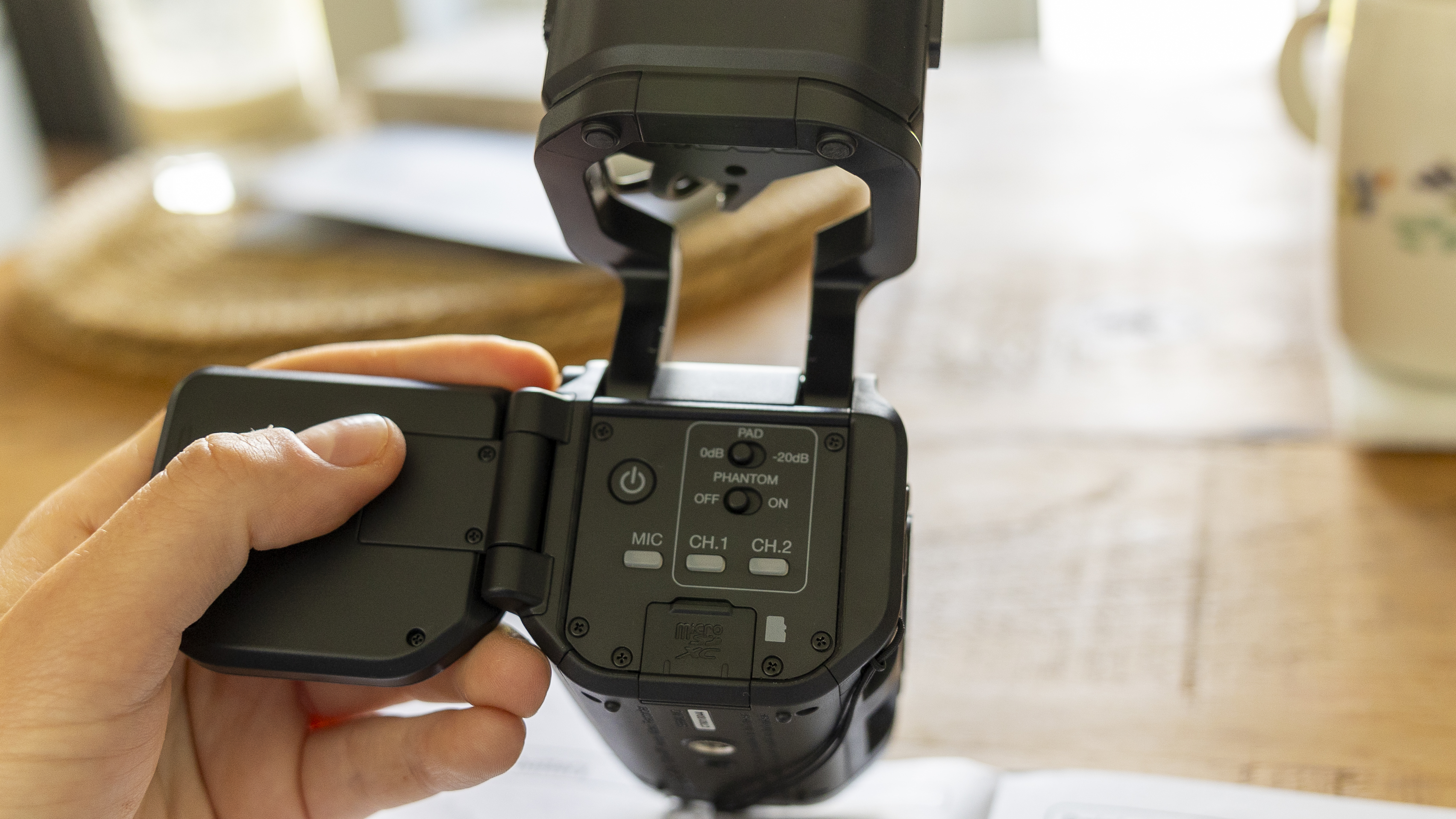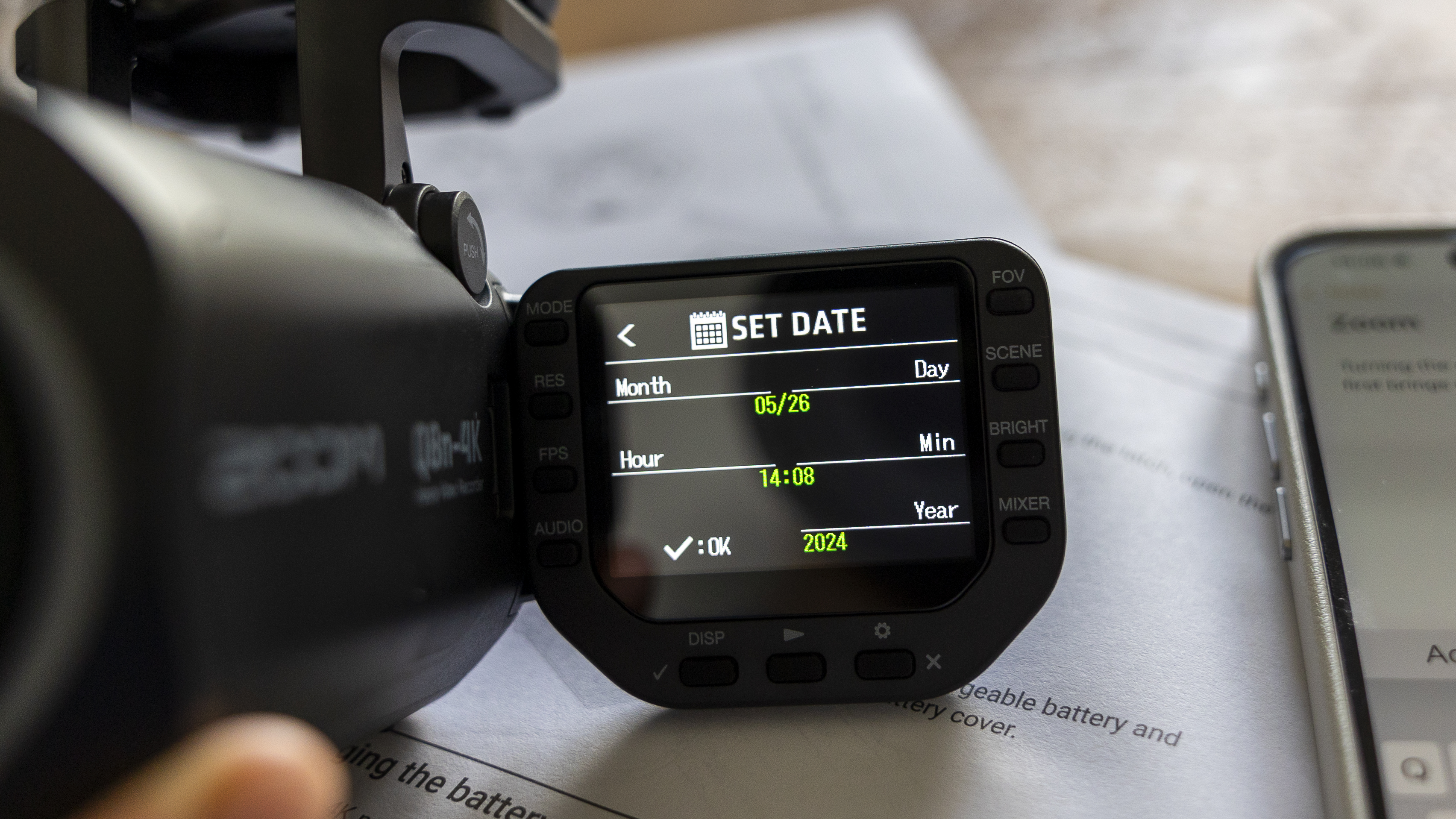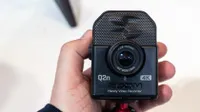Digital Camera World Verdict
The Zoom Q8n-4K is a portable, creator-friendly camera with two onboard microphones and two XLR mic ports. Being able to record four audio tracks simultaneously allows versatile recordings at gigs, concerts, or your home studio. However there are no exposure controls, and I found the detail and dynamic range from the footage poor in low light. This handy recorder is easy to use if you're getting into music content creation, and great value for enthusiasts wanting clips for YouTube or Instagram reels. The audio quality is much better than what you'd get from a smartphone, but the visuals (even though 4K) let the package down.
Pros
- +
Very easy to use
- +
4K video resolution
- +
Crisp, 4-track audio
Cons
- -
Limited fields of view
- -
Sometimes awkward design
- -
Not brilliant in low light
Why you can trust Digital Camera World
Zoom is a specialist manufacturer known among videographers for making high-quality, portable audio recorders. In fact, it was the only brand I used during the filmmaking modules of my university course when – like most budding creators – I learned that audio is just as important as visual quality when it comes to video.
Zoom makes some of the best audio recorders out there, and its handheld devices are trusted by professionals who need to capture a range of sounds while filming on location. But the Zoom Q8n-4K, one of its latest releases, combines 4-track audio and adds a wide-angle fixed lens camera on the front, to make a portable all-in-one content recorder. It's a successor to the Zoom Q8, an HD video recorder that left some disappointed with the video features.
The Zoom Q8n-4K offers more than a smartphone but is cheaper than a mirrorless or DSLR camera. It's aimed at musicians, teachers, and filmmakers wanting something quick to set up and operate. It's also suitable for podcasters, given that it can record four tracks of audio at the same time.
I'm sometimes surprised that the best camcorders are still going steady, and the release of the Zoom Q8n-4K surprises me even more. But with 4K resolution at 30fps, an f/2.8/150º wide-angle lens, and its multi-mic input capabilities, I can see this being a hit with music students and YouTubers who value audio in their production. I tested it for several weeks to discover whether it's a one-trick pony or a genuinely handy video recorder for different creators.
Zoom Q8n-4K: Specification
| Sensor | 1/2.3-inch 16 M-pixel CMOS sensor |
| Lens | f/2.8, 150° FOV (5 steps) |
| Video format | MPEG-4 AVC/H.264 (MOV) |
| Video resolutions | 4K (30fps, 25, 24), 1080/720 (60fps, 50, 30, 25, 24) |
| Audio formats (WAV) | 96 kHz/24-bit, 16-bit | 48 kHz/24-bit 16-bit | 44.1 kHz/24-bit, 16-bit |
| Audio inputs | 2 x XLR microphone, XY Mic: XYQ-8 (120° XY stereo mic) |
| Memory card | microSD/HC/XC |
Zoom Q8n-4K: Price
The Zoom Q8n-4K scores favorably for price. At around $399/£329, it's slightly more expensive than the aging Panasonic HC-V180 camcorder, and that's limited to Full HD recording rather than 4K. Given that the Q8n-4K is marketed as a step up (or sideways) from using a smartphone, I'm pleased to see that it doesn't cost just as much as the best phones for video recording, as some vlogging cameras do.
Anyone serious about improving their online content should be looking to invest at least as much money as the Q8n-4K. The flip-out LCD screen may be more basic than most modern creators are used to, but for the price, the fact that you're also getting high-quality 4-way audio is impressive.


Zoom Q8n-4K: Design & Handling
The Zoom Q8n-4K takes some of its design cues from the Zoom Q8 before it, with a long cuboid design that folds in on itself for neat carrying. It's about the right size to fit in a palm; solid-feeling but not too cumbersome, and the plastic exterior feels smooth rather than cheap. Looking at the recorder front-on, the lens cap unscrews easily and is attached to a cord so you don't lose it. There's a big red power button directly above it, which isn't as springy as I'd like but is at least very obvious.
The best camera deals, reviews, product advice, and unmissable photography news, direct to your inbox!
On the right side, a large cover unclips fully to reveal the battery, and above this, there's a "push" button to unlock the microphone unit and rotate it upwards to reveal the LCD screen behind it. On the left are two 3-pin XLR microphone inputs with corresponding volume button dials above (between 0-10), a 3.5mm headphone jack, and a micro-HDMI and USB-C port. The dials are smooth and satisfying to turn, but I found the numbers hard to see in a dim concert environment and larger, brighter printed numbers would have helped with handling here.
The Zoom Q8n-4K's entire design concept is puzzling, partly because the Q8 is more like a traditional camcorder – it has a flip-out LCD touchscreen revealing key buttons behind. Instead, to use the Q8n-4K (and access the memory card slot or power button) you need to move the retractable mic arm upwards and open out the LCD screen – which adds unnecessary steps. You're also slightly limited by the angles you can shoot without a fully articulating screen. Interestingly, the camera takes microSD, microSDHC, and microSDXC cards up to 512 GB, whereas the Q8 takes SD cards.



Turning the camera on with the power button first brings up a language selector, followed by some prompts for the date and time. Once these are in, you're ready to start filming should you want to. Powering up the recorder does take a few seconds, and it's made more awkward by the fact that the button is behind the 2-inch LCD screen, meaning you either have to pull it out if it's faced towards you or turn the recorder around to find it if you're recording vlogging footage.
Minor gripes aside, I like how easy navigation is on the Zoom Q8n-4K, given you can change all the key settings using the labeled buttons arranged around the LCD screen. FOV means Field of View, for example, and you can toggle through the five different camera views (from Wide to Tele) by repeat presses of the button. Of course, this approach isn't ideal if you miss your setting, as you have to toggle through all the options again to get to your choice.
It's simple and works, but a touchpad or arrow pad would have been a better choice. The LCD also feels small, cramped, and low-resolution (320 x 240), but this is a well-priced budget choice rather than a fully-fledged mirrorless model for pros, and corners had to be cut somewhere.
Zoom Q8n-4K: Performance
Despite having very grab-friendly dimensions, the Zoom Q8n-4K isn't a recorder you'll want to use handheld often. For a start, it doesn't have the stabilization smarts to support that sort of application – I found walking clips very stuttery when compared to my iPhone 15's smoothed footage – and it also feels awkward to hold it in your hand for too long, use the settings buttons, and potentially support any XLR mics simultaneously. You'll want to use the 1/4-inch-20 female tripod thread to mount the Q8n-4K for most things, but it's more than light enough to sit atop a mini tripod.
Visually, the footage is as I expected it to be from a 1/2.3-inch sensor. There's little depth to scenes, and the recorder's low light performance is poor – which is a shame given this is the environment where so many gigs and concerts happen. The scene modes did little to change the image style, and I failed to get a rich, detailed video with any of them. It's nice to have a range of frame rate options (24/25/30fps) but I'd have to keep the resolution at 4K for the most usable content.
By default, the camera has a 150-degree field of view, which is nice and wide for fitting in small rehearsal rooms, and that most prolific of locations – the YouTuber's bedroom. I disliked having buttons to step the zoom rather than a rolling ability to zoom in and out of your chosen subject subtly, and the video quality dipped noticeably at full zoom so I used it sparingly. Pressing the FOV button was also audible on clips, so I'd advise against doing this during an important recording.
I had to remind myself of the Zoom Q8n-4K's low price during testing, but I still found the LCD frustratingly small. Previewing video on a bigger monitor via the micro HDMI output was easy and helped me to pay attention to what I was filming properly. This handy recorder is also incredibly versatile, and you can plug it into a PC or Mac via USB-C to use it as a webcam, mic, or SD memory card reader. It was also picked up automatically by Google Meet, with audio quality crisper than my computer but video quality much darker and grainier than my iMac's built-in webcam.
If the visual quality was expected but disappointing, the audio quality from the Zoom Q8n-4K was surprising and exceeded my expectations. The X/Y mics up top were subtle enough to put up crowd ambience at a live music event, and conversations from passers-by in the street while filming buskers.
The mixer on the screen made it easy to check the levels and effects for all four channels, and you can easily balance the audio sources while filming. I used the helpful headphone jack to monitor the sound more carefully, as the camera's speaker is very quiet and tinny. While I haven't yet had the chance to record a full show with all four channels, I can see how useful it'd be to plug a mic for vocals and a direct instrument, or a mixing board straight into the XLR ports. Being able to record audio and video in a combined file, multi-channel audio, or stereo audio only adds to the Q8n-4K's versatility as a content-creation tool.
While its video quality isn't pristine, the Q8n-4K offers enough options for budding musicians to capture clips for social channels. It fulfills its brief of a jack-of-all-trades recorder and for many will be the stepping stone they need from smartphone to semi-professional recordings of their live performances.
Zoom Q8n-4K: Sample video
Above: sample video clips shot with the Zoom Q8n-4K in a variety of conditions
I had the Zoom Q8n-4K for several weeks. I captured footage and audio in various scenarios – in a crowd at live music events, at home recording my keyboard, and out in the field for vlogging scenarios. I tested the video at all resolutions and the audio at all sampling frequencies.
*The wind noise in the outdoor clips is an unfair representation of the Q8n-4K's audio capabilities. It's not designed for that usage, and I didn't have the windscreen on.
Zoom Q8n-4K: Verdict
If you’re a musician or YouTuber looking for an all-in-one video and audio recorder, the Zoom Q8n-4K is an affordable albeit niche option. I found its design awkward compared to a traditional camcorder or vlogging camera, and easiest to manage when used on a tripod or support – which is likely what you'd do if you were recording yourself. While the Q8n-4K is compact, its cuboid shape is unusual to handhold, and I wanted the screen to be bigger, brighter, and sharper.
One of the great things about the Zoom Q8n-4K is that you don't need much technical knowledge to start using it, or to get decent results. You can monitor audio using the LCD screen as a guide, and tweak the unit's microphone volume via a dial on the top. Its simplicity is also a downside, as this product doesn't give you any manual control over exposure settings, which means you're reliant on its metering even in dim conditions. You also don't get the option to change lenses or zoom in and out more gradually than the preset fields of view, which can be annoying making transitions feel more cinematic.
The Zoom Q8n-4K is not just a camcorder but a fully-fledged audio recorder that can capture your music and vocals admirably. If you're looking for a portable recorder that you can set up in one place and rely on for great-sounding audio recordings at gigs, concerts, or in a home studio setup, the Zoom Q8n-4K is a great buy. If you're looking for high-end visuals and a raft of video settings, there are better buys.
✅ Buy this if...
- You want an extra angle for multi-camera live streaming.
- You're a creator wanting an all-in-one for recording YouTube performances.
🚫 Don't buy this if...
- You want to be able to control and change the exposure settings.
- You're looking to shoot big productions with multiple cameras.
Zoom Q8n-4K: Alternatives
Zoom Q2N-4K
The Q2N-4K is Zoom's battery-powered recorder with UHD 4K video recording. It's also designed for live music and rehearsals, with X/Y microphones built-in. Without a screen, it's hard to review performances on the spot.
Sony ZV-1F
Sony's cheapest vlogging camera has eye detection autofocus and stabilization for greater vlogging versatility. The 20mm prime lens is fixed, and you'll definitely need to buy an external microphone for better audio quality.

Lauren is a writer, reviewer, and photographer with ten years of experience in the camera industry. She's the former Managing Editor of Digital Camera World, and previously served as Editor of Digital Photographer magazine, Technique editor for PhotoPlus: The Canon Magazine, and Deputy Editor of our sister publication, Digital Camera Magazine. An experienced journalist and freelance photographer, Lauren also has bylines at Tech Radar, Space.com, Canon Europe, PCGamesN, T3, Stuff, and British Airways' in-flight magazine. When she's not testing gear for DCW, she's probably in the kitchen testing yet another new curry recipe or walking in the Cotswolds with her Flat-coated Retriever.





